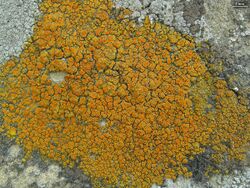Biology:Polycauliona bolacina
| Polycauliona bolacina | |
|---|---|

| |
| in the Santa Monica Mountains, southern California | |
| Scientific classification | |
| Domain: | Eukaryota |
| Kingdom: | Fungi |
| Division: | Ascomycota |
| Class: | Lecanoromycetes |
| Order: | Teloschistales |
| Family: | Teloschistaceae |
| Genus: | Polycauliona |
| Species: | P. bolacina
|
| Binomial name | |
| Polycauliona bolacina (Tuck.) Arup, Frödén & Søchting (2013)
| |
| Synonyms[1] | |
| |
Polycauliona bolacina, the waxy firedot lichen, is a species of saxicolous (rock-dwelling), crustose lichen in the family Teloschistaceae.[2] It is found in western North America.
Taxonomy
The lichen was first formally described as a new species in 1866 by American botanist Edward Tuckerman in 1866, as Placodium bolacinum.[3] Ulf Arup and colleagues transferred the taxon to the genus Polycauliona in 2013, as part of a molecular phylogenetics-based restructuring of family Teloschistaceae.[4] The species is commonly known as the "waxy firedot lichen".[5]
Description
Polycauliona bolacina is characterized by a thallus that has a yellow-orange color, often with a somewhat waxy texture. Its structure is primarily made up of thick [[Glossary of lichen terms#{{biology:{1}}}|{{Biology:{1}}}]] or convex [[Glossary of lichen terms#{{biology:{1}}}|{{Biology:{1}}}]], which are either scattered or situated closely together. These components can extend up to 2 mm across and are slightly [[Glossary of lichen terms#{{biology:{1}}}|lobed]]. The apothecia (fruiting bodies) range from 0.7 to 2 mm in diameter, with orange [[Glossary of lichen terms#{{biology:{1}}}|{{Biology:{1}}}]] and margins that are slightly paler in comparison. The tissues of the apothecia, including the [[Glossary of lichen terms#{{biology:{1}}}|{{Biology:{1}}}]] and cortex, consist of elongated cells arranged in an irregular pattern. Within the medulla, there are few crystals present. The [[Glossary of lichen terms#{{biology:{1}}}|{{Biology:{1}}}]] of Polycauliona bolacina measure between 12.5 and 17.5 μm in length and 5.5 to 8.5 μm in width, with a septum that is 3 to 5.2 μm thick.[5]
Species interactions
Sclerococcum knudsenii is a lichenicolous fungus that has been recorded growing on P. bolacina in California .[6]
References
- ↑ "Synonymy. Current Name: Polycauliona bolacina (Tuck.) Arup, Frödén & Søchting, Nordic Jl Bot. 31(1): 51 (2013)". Species Fungorum. https://www.speciesfungorum.org/Names/SynSpecies.asp?RecordID=802091.
- ↑ "Polycauliona bolacina (Tuck.) Arup, Frödén & Søchting". Species 2000: Naturalis, Leiden, the Netherlands. https://www.catalogueoflife.org/data/taxon/4L3GL.
- ↑ Tuckerman, E. (1866). Lichens of California, Oregon and the Rocky Mountains, so far as yet known. Amhurst: J.S. & C. Adams. pp. 1–35 [18]. https://archive.org/details/lichensca00tuck/page/18/mode/2up.
- ↑ Arup, Ulf; Søchting, Ulrik; Frödén, Patrik (2013). "A new taxonomy of the family Teloschistaceae". Nordic Journal of Botany 31 (1): 16–83. doi:10.1111/j.1756-1051.2013.00062.x.
- ↑ 5.0 5.1 Brodo, Irwin M.; Sharnoff, Sylvia Duran; Sharnoff, Stephen (2001). Lichens of North America. Yale University Press. p. 197. ISBN 978-0-300-08249-4.
- ↑ Zhurbenko, Mikhail P. (2022). "Sclerococcum knudsenii (Ascomycota, Sclerococcales), a new lichenicolous fungus on Polycauliona bolacina from California". Herzogia 35 (1): 131–137. doi:10.13158/heia.35.1.2022.131.
Wikidata ☰ Q26385446 entry
 |

